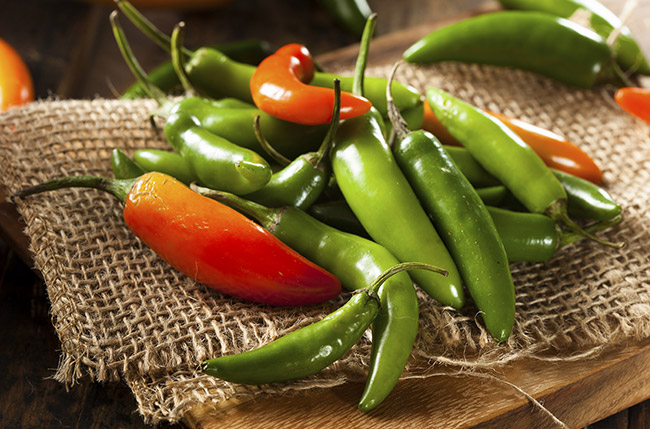
Serrano peppers are one of the hottest peppers that are readily available and popularly used in North America. There are certainly much hotter peppers available, but serranoes are the spiciest pepper that can be easily found at any grocery store. The spiciness of serranoes ranges from 10,000 to 25,000 Scovilles, which makes them significantly hotter than jalapeños. The name of the serrano comes from the Spanish word meaning “highland,” due to the pepper’s origin in hills of Puebla, Mexico. Serranoes are often used in traditional Mexican cuisine, Tex-Mex dishes and is popularly used in Asian, Middle Eastern and Mediterranean recipes when more traditional peppers are unavailable. Like jalapeños, serrano peppers can be used when they are unripe, or more mature. Serranoes typically turn red when ripe, but they sometimes turn brown, orange, yellow, or even stay green when ripe.
Serranoes are immensely popular in Mexican cooking, and like jalapeños, serranoes can be used to spice up almost any dish. This pepper is often used in salsa and pico de gallo, because the spicy bite and acidity of this chili pairs well with tomatoes. Serranoes are generally used fresh, but they can be dried or pickled to improve their shelf life. Sautéed serranoes can be combined with pureed tomatillos for a spicy, tangy salsa verde. Serrano peppers are often used to spice up chili, salsas, refried beans, and nearly any Mexican or Tex-Mex recipe. Curries can also benefit from a little serrano pepper for added heat. Serranoes are great with seafood dishes, especially shrimp. Serranoes can also be diced and added to bland store-bought dips like hummus or plain guacamole to add a flavorful kick.
A fresh serrano will have smooth skin and be firm to the touch. They are commonly sold green and unripe, and they can also be found ripe and colorful. The pepper is perfectly usable in its green, immature form, and waiting for it to ripen and turn color will have little or no effect on the flavor. Store serranoes in the refrigerator where they will stay fresh for about a week. When the skin of the serrano wrinkles and the flesh becomes soft, the pepper is no longer good and should not be used. When preparing serranoes, wash with cool water and pat dry. Remove the stem by slicing off the cap of the pepper. If less heat is desired when using serranoes in a recipe, remove the seeds and membranes inside the pepper. To do this, slice the pepper lengthwise and scrape out the seeds and membranes with a spoon and discard them. It is important to remember while working with spicy peppers to thoroughly wash your hands before touching your eyes or other sensitive body parts, as the oils in the peppers can cause serious irritation.


 BACK TO PRODUCTS
BACK TO PRODUCTS